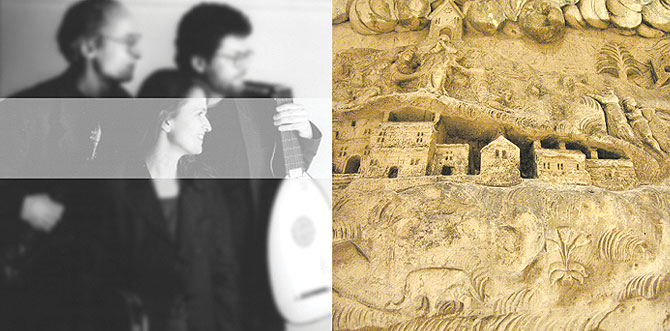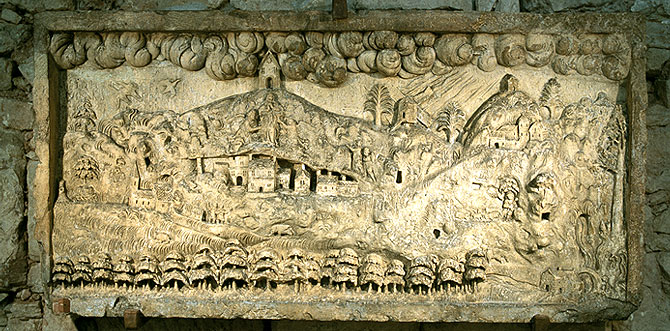7
autumn – autumnus
between the times
autumn timeless - journeys of discovery through space and time

The limestone relief
Two dovetail-shaped carvings on the upper side of the limestone relief found in the Wintringen chapel indicate that it could be used as a predella of an altar. It depicts a village landscape with surrounding nature and wandering people. The main scene is an apparition of Mary with two adoring angels. Mary hovers protectively over the houses of a village and a church. However, secondary scenes also allow other interpretations. The image of a scallop shell in the scenery could also be interpreted as a reference to the scene of a pilgrimage. The depressions in the limestone probably served candle or pine chip holders, which could illuminate the scene in the dark.

The relief corresponds to the artistic spirit of the presumed period of origin (16th century), in which the foreign was emphasized. Earthly paradises, exotic people, plants and animals were handed down from antiquity or the Orient. The reports of explorers had a particularly inspiring effect. They were responsible for the increased interest in the foreign and exotic.Besides all this, the scenery also conveys the individual imagination of its creator of domestic and distant landscapes.
The intention of the seventh event in autumn 2005 was to approach the artistic statement of the unknown sculptor of the relief in the Wintringer Chapel musically. From this stone-formed reaction of a human memory and imagination - to all appearances a journey of discovery of the creator immortalized in stone - the nationally known trio "between the times" ventured a musical mediation between the times. The musical spectrum ranged from composition to improvisation and created a dense and contemplative atmosphere in the Wintringer Chapel on October 2, 2005. The audience took part in a time travel through half a millennium.
Our journey through time takes us, starting from the season of autumn, to the time of the origin of the "chapel" in the 15th century and beyond, to even more distant centuries, where the origins of this former Premonstratensian priory lie.
Our musical search for traces led us to Languedoc in the time of the troubadours with their occidental melodies, to Spain in the time of Alfonso the Wise (pilgrimage songs "Cantigas des Santa Maria") and finally also to the Wintringer Chapel, where the petrified message of this limestone relief - which can possibly also be interpreted as a travelogue - inspired us.
Our own journey of concerts in special spaces - from the church remnant in Lorsch Monastery, a concrete silo, to this concert in the Wintringer Chapel, supports our long-held desire to record a CD in the courtyard of the famous Castel del Monte.
Since much of our music consists of improvisations that come from the moment, the "genius loci" of this particular place and the specific scenes of the limestone relief preserved here naturally have a significant influence on our playing.
Ute Kreidler, during the concert

between the times
The musicians of this unusual ensemble move between times and styles. The two founders, saxophonist Knut Rössler and lutenist/guitarist Johannes Vogt fused jazz improvisations and timeless melodies of the Middle Ages into new pieces of music (CD Between The Times).
In the trio with the soprano Ute Kreidler, traditional European songs served as a model for interpretations between old music, regional styles and instrumental improvisations (CD "Im Silo" with themes from old music as well as Sephardic melodies; CD "Between The Times live" at the Jazz Festival in Worms with a focus on Spanish and Sephardic songs). The current program, which can be found on the latest CD "Early Songs", is dedicated to old northern European songs from Finland, Sweden, Scotland, Ireland and Wales. Common to the melodies is a tone tending to melancholy, which shines through even with various instrumentations. The songs played in the "Chapel" have been edited by the musicians to the space, the relief and its mood.



